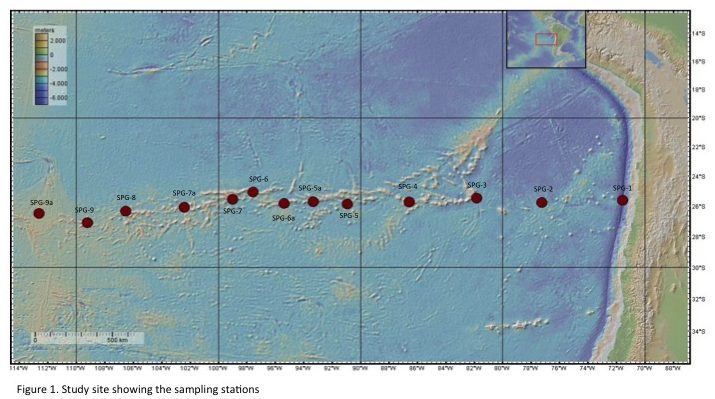[from Deep-Sea Life Vol 12]
Deep-sea soft-bottom benthic communities: Exploring biogeography and genetic connectivity of southeast Pacific Seamounts
Eulogio Soto (1), Eduardo Quiroga (2)
(1) Universidad de Valparaíso, Chile; (2) Pontificia Universidad Católica de Valparaíso, Chile
Email: eulogio.soto@uv.cl, eduardo.quiroga@pucv.cl
Deep-sea benthic communities inhabiting the sediment seafloor of seamounts located in the southeast Pacific Ocean will be investigated. The study site will cover a longitudinal transect at 25-26°S from Chilean continental margin (77°W) to the Indo-West Pacific Region (112°W), exploring target seamounts on Nazca Ridge (Nazca-Desventuradas Marine Park), Salas y Gomez Ridge and near Easter Island (now named Rapa Nui). The main goals will be to investigate the biogeography and genetic connectivity of benthic communities; assess their response to different food supply regimes in terms of biodiversity, benthic standing stock, and describe the main sediment drivers (biogeochemical variables) affecting to the fauna distribution patterns. In this sense, seamounts from highly productive areas to oligotrophic areas will be sampled to test a first hypothesis related to how different food supply regimes to the seabed influence the benthic standing stock and biodiversity. Additionally, we postulate that Salas y Gomez Ridge would be a transitional zone between Nazca Ridge and Easter Island Ridge, therefore this zone may act as biogeographic-genetic ‘stepping stones’ between both zones. The oceanographic cruise will be carried onboard R/V Mirai in 2019 and sediment samples will be taken on target seamounts using Multiplecorer and Agassiz trawl. Results will allow the description of soft-bottom benthic fauna from one of the most unexplored regions in the world; to improve our knowledge and understanding of biogeographic distribution patterns and their genetic connectivity and assessing the standing stock response to different food supply regimes for this fauna. Information obtained will allow a review of the geographic boundaries of bathyal benthic fauna in the region and support management measurements for newly created Marine Protected Areas, considering the current high fisheries pressures, global change increasing and relevant conservation categories (VME, EBSAs) that these seamounts have.
The project is led by Dr Eulogio Soto (Universidad de Valparaíso) and Dr Eduardo Quiroga (Pontificia Universidad Católica de Valparaíso) both from Chile. Dr Greg Rouse (Scripps Institution of Oceanography, University of California in Sand Diego) and Dr Jeroen Ingels (The Florida State University) are scientific partners. The research is part of the “East/ Central Pacific International Campaign (EPIC)”, MR18-06 on board the R/V Mirai, Jamstec and will take place during Leg 3 (Chief Scientist: Dhugal Lindsay, Jamstec) from 27 January 2019, Valparaiso, Chile to 2 March 2019, Papeete, Tahiti, French Polynesia.
Post-cruise funding is highly required and necessary for sample analysis and outreach.


